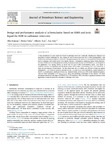Design and Performance Analysis of a Formulation Based on SDBS and Ionic Liquid for EOR in Carbonate Reservoirs

Use this link to cite
http://hdl.handle.net/2183/30046
Except where otherwise noted, this item's license is described as Atribución-NoComercial-SinDerivadas 4.0
Collections
- Investigación (EPEF) [590]
Metadata
Show full item recordTitle
Design and Performance Analysis of a Formulation Based on SDBS and Ionic Liquid for EOR in Carbonate ReservoirsDate
2022-02Citation
SOMOZA, A., TAFUR, N., ARCE, A. y SOTO, A. Design and performance analysis of a formulation based on SDBS and ionic liquid for EOR in carbonate reservoirs. Journal of Petroleum Science and Engineering, 2022, vol. 209, pp. 109856. ISSN 0920-4105. DOI https://doi.org/10.1016/j.petrol.2021.109856.
Abstract
[Abstract] A large proportion of extant crude oil is found in carbonate reservoirs worldwide. Alkylbenzene sulfonates are inexpensive anionic surfactants but they cannot be used in these reservoirs due to their incompatibility with divalent ions and high adsorption on the rocks. This paper proposes the solution to that problem by blending this kind of surfactant with surface-active ionic liquids. Namely, a formulation containing sodium dodecylbenzenesulfonate (SDBS) and cocosalkylpentaethoximethylammonium methylsulfate ([C1EG][MeSO4]) was designed for the application. Two optimal blends, at 40/60 and 73.7/26.3 SDBS/[C1EG][MeSO4] ratios, were found in synthetic seawater via equilibria and interfacial tension (IFT) studies. Core-flooding tests were carried out to check the performance of both blends. The first blend ratio (40 wt% SDBS) was selected to define an optimal formulation (1 wt% blend in synthetic seawater at 298.15 K) due to its better injectability, higher reduction of the IFT, lower adsorption, and better oil recovery. Attained tertiary oil recovery (18% of the original oil in place), with low blend adsorption (0.37 mgblend/grock), shows the promising performance of the solution. The main mechanism associated with improved oil recovery is IFT reduction. This work offers a significant advance in the application of natural petroleum sulfonates in carbonate reservoirs.
Keywords
Anionic
Cationic
Synergy
Microemulsion
Cationic
Synergy
Microemulsion
Editor version
Rights
Atribución-NoComercial-SinDerivadas 4.0
ISSN
0920-4105






